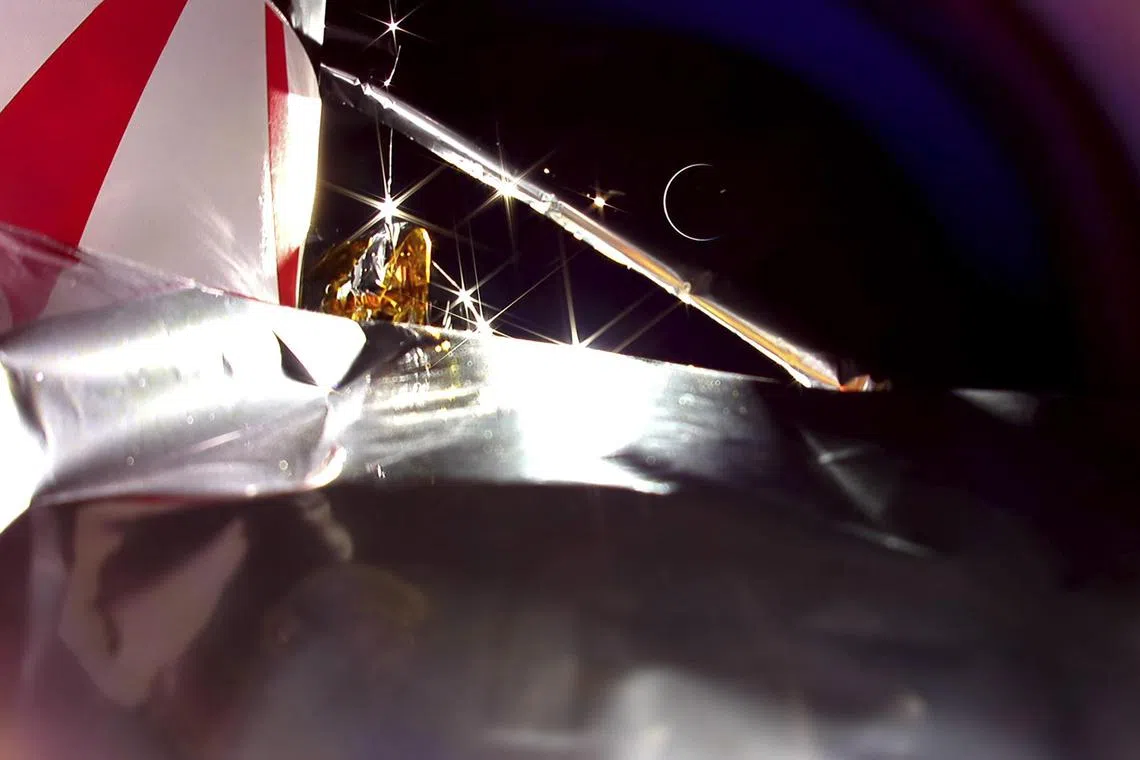US firm’s moon lander disintegrates in Earth’s atmosphere
Sign up now: Get ST's newsletters delivered to your inbox

A view of Earth from Astrobotic Technology’s Peregrine spacecraft on Jan 18.
PHOTO: NYTIMES
Follow topic:
WASHINGTON - A spacecraft that was headed to the surface of the moon has ended up back on Earth instead, burning up in the planet’s atmosphere on the afternoon of Jan 18.
Astrobotic Technology of Pittsburgh announced in a post on social network X, formerly Twitter, that it lost communication with its Peregrine moon lander at 3.50pm local time (4.50am Singapore time on Jan 19).
This served as an indication that it entered the Earth’s atmosphere over the South Pacific at 4.04pm.
On Jan 19, the United States Space Command confirmed the destruction of Peregrine. Astrobotic will bring together a review board of space industry experts to figure out what went wrong.
It was an intentional, if disappointing, end to a trip that lasted 10 days and covered more than 804,670 km, with the craft travelling past the orbit of the moon before swinging back toward Earth. But the spacecraft never got close to its landing destination on the near side of the moon.
The main payloads on the spacecraft were from Nasa, part of an effort to put experiments on the moon at a lower cost by using commercial companies. Astrobotic’s launch was the first in the programme, known as Commercial Lunar Payload Services.
Nasa paid Astrobotic US$108 million (S$145 million) to transport five experiments that cost US$9 million to build.
Peregrine launched flawlessly Jan 8
But soon after it separated from the rocket’s second stage, its propulsion system suffered a major malfunction,
Astrobotic’s engineers were able to get Peregrine reoriented so its battery could recharge. But the leaking of propellant made the planned moon landing impossible.
The company’s current hypothesis is that a valve failed to close, causing a high-pressure flow of helium to rupture a propellant tank.
Astrobotic initially estimated that Peregrine would run out of propellant and die within a couple of days.
But as the leak slowed, the spacecraft continued to operate.
All 10 of the powered payloads, including four from Nasa, were successfully turned on, demonstrating that the spacecraft’s power systems worked.
The fifth Nasa payload, a laser reflector, did not need power. Other customer payloads, including a small rover built by students at Carnegie Mellon University and experiments for the German and Mexican space agencies, were also powered on.
“After that anomaly, we just had victory after victory after victory, showing the spacecraft was working in space,” said Astrobotic chief executive John Thornton during the Jan 19 news conference.
Over the weekend, the company said that the spacecraft, nudged off course by the propellant leak, was on a path to burn up in Earth’s atmosphere.
The company said it had decided to leave Peregrine on that trajectory to prevent the possibility of the crippled spacecraft colliding with satellites around Earth.
More landers are aiming for the moon.
On Jan 19, a robotic Japanese spacecraft currently orbiting the moon, Slim, achieved a lunar landing,
The next Nasa-financed commercial mission, by Intuitive Machines of Houston, could launch as soon as mid-February.
Astrobotic has a Nasa contract to take a much bigger payload to the moon: the Volatiles Investigating Polar Exploration Rover (Viper).
Viper is to drive around the moon’s south polar region, including entering permanently shadowed craters that are some of the coldest places in the solar system. That mission is to gather key scientific reconnaissance before astronauts head there.
Although the cost of the Nasa experiments on Peregrine was US$9 million, Viper will cost more than US$430 million to build and operate, and it is to ride aboard Astrobotic’s bigger lander, Griffin.
The Viper mission is scheduled to launch in November, but that would mean Nasa would have to fly a key, expensive vehicle on an unproven spacecraft from a company that has not successfully landed on the moon yet.
Deputy associate administrator for exploration in Nasa’s science directorate Joel Kearns said during Jan 19’s news conference that he wanted to see the results of the investigation into what went wrong with Peregrine before deciding whether to make any changes in its contract with Astrobotic for the delivery of Viper.
“We want to make sure we really understand the root cause and contributing factors of what happened on Peregrine,” Dr Kearns said, “and if we have to modify our plans for Griffin.” NYTIMES

